When I started playing volleyball, one of the most fundamental things that was covered wasn’t related to ball-handling skills, strategy, or even athleticism. It was about rotating, and your position on the volleyball court. Understanding these fundamentals is one of the first things you should understand when you start playing volleyball. Trust me – everything else you will learn about volleyball will centre around these concepts.
This guide covers these two key and important aspects of volleyball: the rotation positions (where players stand on the court during each rally), and the specialized player roles. While these are two individual concepts, they also affect each other. So it’s difficult to cover one without covering the other as well. Let’s start with the rotation positions, then get into the specialized players roles below.
Volleyball rotation positions
Anyone that has played even the most basic game of volleyball knows that each of the six players on the court takes a turn serving. The service order is not random – at the beginning of the game, players line up in a specific position, and they need to maintain that order during the game. Diagram 1 shows the rotation positions. The numbers identify the serving order.
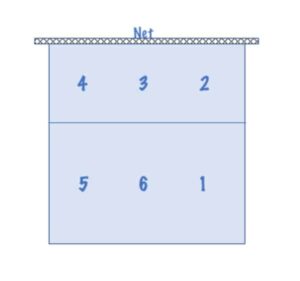
It’s also important to know that the position numbers DON’T CHANGE, but the players move through the positions. For example, position 2 is always in the front court on the right hand side, and position 6 is always in the middle of the back court. If it helps, imagine that the numbers in the picture above are actually written on the volleyball court! A player will START in a numbered position, but as they rotate throughout the game, each player moves through each of the numbered positions.
The player in position 1 will start the rally with a serve, and will continue to start each rally with a serve until her team loses a rally. That is called a sideout for the other team.
When a team gets a sideout, the players on that team then rotate in a clockwise direction so that the next player gets to serve. That means that the player who was standing in position 2 will now rotate into position 1, and will be the next server to start the rally.
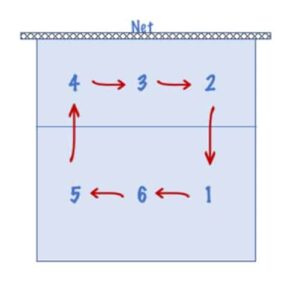
The team that lost a sideout rally does not rotate. They need to wait until they get a sideout rally to rotate. So, only one team at a time rotates – there would never be a rally where both teams would rotate.
Getting called “out of rotation”
There are two ways that a team can get called out of rotation: a rotational violation or a positional violation.
Players need to serve in the rotational order that they started in for the whole game, even as they rotate with each sideout. If players get the serving order mixed up, the referee will call a rotational violation, which means the team loses a point, and the other team gets the serve.
There’s also a positional out of rotation violation. This one’s a little more complicated – but stay with me, it’ll make sense, I promise.
On the volleyball court, there’s always three front court players, and three back court players. When you see them lined up on the court, each of the front court players lines up with a back court player. During the serve, the front court player has to stay in front of the back court player that they’re lined up with. So, the player in position 2 needs to be in front of the player in position 1, player 3 needs to be in front of player 6, and player 4 needs to be in front of player 5.
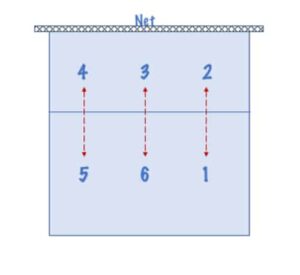
In addition to that, each of the players can’t overlap with the players beside them. So, player 2 has to stay to the right of player 3, player 4 has to stay to the left of player 3, and then obviously, player 3 has to stay between players 4 and 2.
The same thing applies for the back court players as well: player 6 has to stay between players 5 and 1.
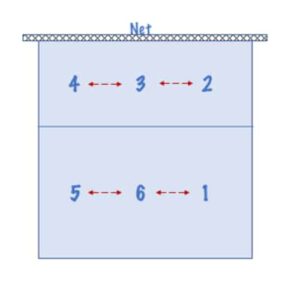
So, if a player doesn’t line themselves up properly with either their corresponding front or back court teammate, or with their lateral teammate, they could get a positional violation call, and lose a point.
Remember, this is just during the serve. After the serve has crossed the net and the rally has started, the players can move around each other as much as they need to. In fact, they will even switch into different positions to maximize their skills and strengths. More on switching and specialized roles below!
Keeping the front court players in front of the back court players, and making sure that players aren’t crossing each other laterally is pretty straight forward when the players are just standing in their rotational positions. But, when they line up for a serve receive, they position themselves strategically to optimize their passing potential. Some serve receives can be pretty straight-forward:
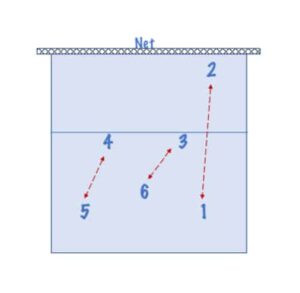
Here you can see that player 2 is still in front of player 1, player 3 is in front of player 6, and player 4 is in front of player 5. Also, player 6 is still between players 5 and 1, and player 3 is still between players 4 and 2.
Here is a more complicated serve receive setup:
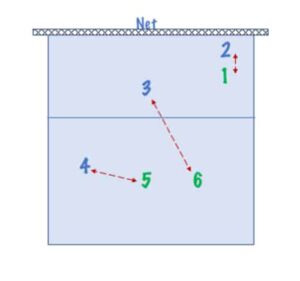
The backcourt players are in green, while the front court players are in blue. You can see that all the backcourt players are still behind their corresponding front court player, player 3 is still between players 4 and 2, and player 6 is still between players 5 and 1.
But why would you ever want to complicate your positional rotation so much? Why not just keep it as simple as possible? Well, when you give players specialized roles, you need to get them into the position that makes their job as easy as possible. So let’s talk about what are the specialized positions, then revisit this more-complicated serve receive setup.
Specialized positions in volleyball
Having specialized positions means is that while each player should know the basic skills of volleyball, they also each have a specific role to play on the court.
Having players with specialized roles means that teams can run more sophisticated plays. Players can really focus on building the specific skills needed for their role. And it also means they need to coordinate well as a team, and communicate with each other. This kind of communication is always easier when there’s good team chemistry. Check out this article to learn more about how you can IMPROVE TEAM CHEMISTRY.
This may sound complicated, but it actually makes things really easy. When each player knows their specific role, they can stay out of each other’s way (well, usually!)
Here’s a list of the different roles on a volleyball court, followed by a description and some important skills for each to have.
But wait, you say. Aren’t there 6 players on a volleyball court?? Why is there only 5 roles? Well, that’s because there’s actually 2 left side hitters, 2 middle hitters, 1 setter, and 1 right-side hitter. The left side and middle hitters play opposite each other in the rotation, and the setter and the right-side hitter are opposite each other. That means that there’s always 1 left side hitter, 1 middle, and either the setter or right-side player in the front court.
This setup shows each of the specialized roles in their home position:
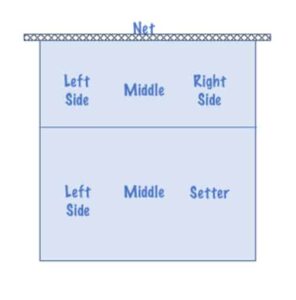
So what about the libero role? Where do they fit on the court? A libero is a defensive specialist, and they only play in the back court. Let’s start by describing a libero role, because it directly affects the other roles.
-
Libero
As mentioned, the libero is a defensive specialist, meaning they don’t attack the ball. Their primary role is to serve-receive, pass, and dig up the ball. That’s why a libero only plays in the back court.
If you’ve ever watched a volleyball game, you’ll notice that one of the players sometimes wears a different colored jersey. That’s how the libero is distinguished, so that it’s easy for the referee to identify.
The libero role is interesting, because this player will literally take over the position of one of the hitters (usually a middle, and you’ll see why below in the middle description) when the hitter rotates into the back court. And the libero doesn’t require an official substitution to do so – they can just replace a player by running onto the court while the other player runs off. This, of course, has to be timed properly, well before the serve. In fact, the timing of this switch cannot interfere with the usual pace of the game, otherwise a delay of game will be called.
There’s lots of small, specific rules for the libero to follow, but the most important one by far is that they can’t rotate into the front court.
With the libero replacing the middle hitter in the back, the players would setup their positions like this:
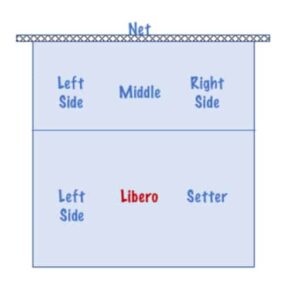
Skills for a good libero
A good libero needs to be an exceptional passer and digger. After all, that’s their only job! They are light on their feet, and really agile. They can read hitters really well, and adjust their defense based on the hitter’s attack (whether they’re hitting the ball hard, doing a roll shot, or tipping).
A good libero will also have a lot of patience. They may not be involved in a lot of plays, but they still need to be alert and ready to react during each play.
-
Left-side, or power, hitter
The left-side hitter is named because when the three front-court hitters are lined up facing the net, the home position for the left-side hitter is on the left, in position 4. Pretty straight forward, right? I guess because there’s other more complicated concepts to know in volleyball, they like to keep things simple when they can!
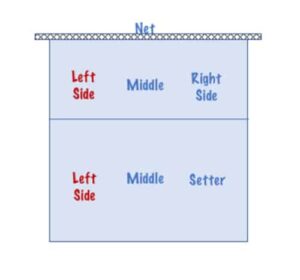
When in the front court, the left-side hitter usually does most of the hitting. Because of their positioning on the court, the left-side hitter generally has the most room to do a full hitting approach, so they get a lot of power and momentum from their approach.
Hitting from the left-side of the court is ideal for a right-handed player, as they can easily adjust to hit down the line or cross-court. Some of the more basic plays that a left-side hitter will hit include a 4 set (or high-ball), and a shoot.
When playing defense, because the home position for the left-side player lines up with the right-side hitter on the other team’s side, in a more recreational game, they often don’t do as much blocking. However, the left-side hitter does a lot of passing, both in the front and back court. That’s because when playing defense, they’re in an ideal position to be lined up for a cross-court hit from the left-side player on the other team.
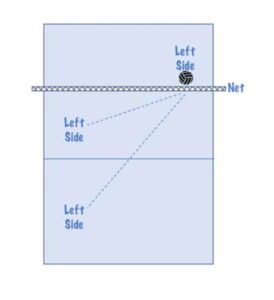
When the left-side player is in the back court, their home position is also on the left side of the court, in position 5.
Skills for a good left-side hitter
A good left-side hitter will be a good attacker. That’s the same thing, right? Well, not exactly. An attack can include a hard driven hit (the classic spike), but it can also include a roll shot, or a tip. A good left-side hitter knows when to pound the ball (and can do so really well), but they should also know when to use a roll shot or a tip to throw off the other team. Looking for holes in the defense or just to switch things up is always a good idea.
A left-side hitter should also be a good passer, both for defense and serve receive. They should also be good at reading the other team’s offense, and reacting to it quickly.
They should also always be ready for the set. If the setter is calling some plays, but then they get a bad pass and can’t run those plays, the backup set is usually a 4 set to the left side hitter. That means that the left-side hitter should always be ready for the set, even if it’s not the type of set they were expecting.
(Quick review: if you ever wondered why it’s called a 4 set, now that you know the positions numbers on the volleyball court, you know that the left-side hitter plays from the 4 position… which means their set is also called a 4!)
-
Middle hitter
You guessed it, the middle hitter hits from the middle of the court, in position 3! Middle hitters tend to be the tallest players on the court, as they do most of the blocking, and height is definitely an advantage for blocking.
The middle role is challenging, because you’re involved in so many of the plays. And even if you’re not involved, you’re right in the middle of the action (pardon the pun!), because you’re right beside the setter. So, when the pass to the setter is off target, it might be going right to where YOU’RE standing.
Middles don’t have the advantage of always getting their full hitting approach. Because they’re usually coming down from a block, they have to quickly get back into their hitting position to be ready for the set. And, as soon as they hit, they’re back into blocking position. It’s definitely a fast-paced role!
Middle blockers are responsible for blocking not only the middle hitter on the other side of the net, but also for helping block the outside hitters as well. That means they have to be quick on their feet to get to the outside of the court to block.
And whenever there’s a tight play or a joust at the net, it’s usually the middle that’s involved. It’s definitely not a boring role!
Since it’s just a fast-paced role in the front court, the middle hitter is usually the player who gets replaced by the libero in the back court. This gives the middle a much needed break to be ready for their next round of offense when the rotation brings them back into the front court.
However, a lot of recreational teams don’t play with a libero, so the middle player needs to play defense in the back court as well.
In the back court, the home position for the libero or middle player is usually the 6-back position, which is in the deep end of the court.
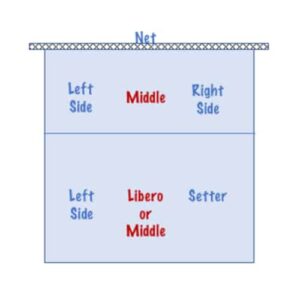
Skills for a good middle hitter
Height is definitely an advantage (yes, I know that’s not a skill!), but being able to jump high and having agility to move laterally is much more important. The main role for the middle hitter is blocking and hitting, so a good vertical is a huge advantage. Being coordinated is also important – you’ll often see a person try to play middle just because they’re tall, but it’s important to have good coordination as well.
While good reaction time is important for all volleyball players, is especially important for middles. The distance the ball travels before they contact it is pretty short, so they don’t have a lot of time to react. Good reaction time is also important for all those close plays at the net.
A good middle will also be able to read the other team’s setter as well, to be able to quickly figure out where the set is going. Since the middle is responsible for blocking every hit along the net, they need to move quickly to where the set is going, and how high it’s going to be.
They also need to be aware if the other setter is in the back or the front court, which makes a difference on the setter’s attacking options. For example, if the setter is in the back court, they can’t just tip the ball over the height of the net to attack. However, if the setter is in the front court, they are also considered an attacker, and can either tip or hit the ball.
-
Right-side hitter
Following the naming pattern that’s been established, the right-side hitter hits from the right side of the net, in position 2. The right-side hitter is definitely an under-rated role.
Right-side hitter is a fundamental role, and requires all of the same skills as the left-side hitter, but the right-side hitter often doesn’t tend to get as many sets, especially in a more recreational setting. The team’s setter needs to have a strong back set, and it’s much harder to set consistent back sets.
That means that not only does the right-side player usually get fewer sets, but those sets are often not as consistent, so the right-side player has to adjust quickly to each set.
To be fair, sometimes it’s not always up to the setter. The passing needs to be pretty on-target to be able to get a good back set option as well. So, if the team isn’t strong in passing, the setter will have a difficult time getting a good enough pass to be able to do a good back set.
If there happens to be a left-handed hitter on the team, they will often get placed in the right-side position. Why? Because of the angle of how a left-handed hitter approaches the ball, it’s much more beneficial for them to be hitting from the right-hand side of the court. They have a more natural angle for choosing to hit a cross-court or down-the-line hit.
That’s not to say that a right-handed right-side hitter doesn’t have these options as well! It just takes a little more practice to be able to swing at the ball with the right angle to aim cross court or down the line.
When the right-side player rotates into the back court, their home position is position 1.
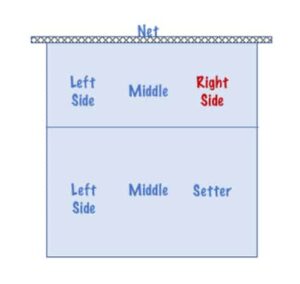
Skills for a good right-side hitter
As mentioned, a good right-side hitter needs to be able to adjust their approach to each individual set, because the sets they’re getting may not be as consistent. They also need to stay really focused, as they may get a set when they’re not expecting it.
The right-side hitter also has to have a strong defensive game. They end up blocking the left-side hitter on the other team, (and remember as we already mentioned, the left-side hitter gets A LOT of sets!) so the right-side hitter does a lot of blocking.
They’re also responsible for setting the block for the middle hitter, so they should have a good eye for judging where the left-side hitter is aiming (down the line, cross-court, or tipping).
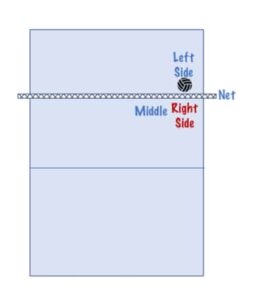
What does setting the block mean? Well, because the middle is quickly moving laterally to get outside to block, the outside blocker acts as kind of a target for the middle to keep in their peripheral vision. The middle doesn’t have the same amount of time to judge the potential angle of the hitter’s hit, so they rely on the outside blocker to “set the block”, which means lining up with the hitter more to the outside (for a down-the-line hit), or more towards the inside (for a cross-court hit). Does that mean that the middle blocker comes crashing into the outside blocker? Well, sometimes! But not really that often!
-
Setter
The role of the setter SEEMS pretty straightforward: set the ball for the hitter to hit. However, there’s always a lot going on during a rally, and the setter has to make a lot of split-second decisions during each rally: which hitter to set, what kind of set to give them, get back into position for defense, where to line up for defense, and then onto the next offensive play.
It’s not unusual for the setter to be involved in every play. In fact, they really SHOULD be involved in every play, since their job is to set up the hitters!
The home position for the setter is either position 1 or 2, depending on if they’re in the front or back court.
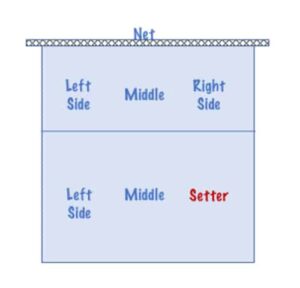
The setter is also really dependent on the passers. If the passing is on target, it makes the setters job way easier. However, if the passing is off-target, the setter is continually running down the ball, and needing to set whichever hitter they can, which can really limit the offensive options.
The setter is often referred to as the quarterback of the volleyball court. This is because in addition to calling the offensive plays, the setter often provides a good deal of leadership on the court. Keeping everyone motivated, keeping the energy up, and even doing some coaching (but not too much!)
Skills for a good setter
Setters are FAST – both physically and mentally! A good setter really needs to have a good understanding about the strategic aspects of the game of volleyball, as they’re a key decision-maker on the court. And they need to have good agility and coordination to run down that second ball for each play.
One of the most important qualities of a setter is consistency. The hitters need to know that the sets they’re getting are going to be consistent, which makes it much easier for them to plan their attack.
The setter also needs to be mentally consistent, and not let any of the psychological aspects of the game bring him or her down. It’s really easy for a team to get in a funk and lose a string of points. It often falls to the setter to try to keep the team’s momentum up, and keep them motivated.
The switch
So now that you understand both the volleyball position numbers, and the roles on the volleyball court, let’s add a new concept that integrates the two: the switch.
If a left-side player is supposed to hit from the left, the middle from the middle, and the right-side hitter from the right side, then how do they do that if they’re only in that rotational position once during the rotation? They SWITCH into it, of course! This means that they literally run into their home position from whichever position they’ve rotated into, staying within the front or back court.
This picture shows an example of the starting lineup rotational order that a team would probably start their specialized players in.
Since the two left-side hitters play opposite each other, the middles opposite each other, and the setter and right-side play opposite, there’s always one of each in the front or back court.
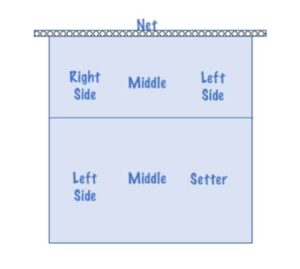
Now, the switch has to be timed properly. Rallies happen FAST in volleyball, and you want to get to your home position as quickly as possible, so that you can concentrate on the rally instead of switching. But you can’t switch TOO early, because you’ll get called out of rotation (remember, depending on where you’re standing, you have to stay on a certain side of your teammate until the serve starts the rally).
The advantage of being the serving team is that you have a couple of extra seconds during the serve to switch. You have to be in your rotational position when the server contacts the volleyball, but then players can quickly switch into their home position while the other team is setting up their offensive attack.
Being the team that is receiving the serve means that you have at least one rally where players aren’t standing in their home position. This doesn’t tend to affect the back court passers very much, but the hitters might need to hit out of a position that isn’t their home position. That’s why being an adaptable player is a great skill for volleyball.
Once the first rally goes over the net, and the serving team is setting up their offense, the serve-receive team now has a few extra seconds for the players to switch into their home position. Players will quickly run into their home positions, while also keeping an eye on where the volleyball is going.
If it’s a fast rally at the net, players should wait for an opportune time to switch. Remember to always play defense first! Even if it’s not your home position. It’s defense first, then switch. Otherwise you might be leaving a gaping hole in the defense positioning. Some players will even call out, “Switch!”, to let their teammates know that they’re switching.
So, there you have rotational positions, specialized roles, and even the bonus topic of switching! Now, let’s go back to that seemingly complicated serve receive, and see if it makes more sense now that we understand player roles and switching.
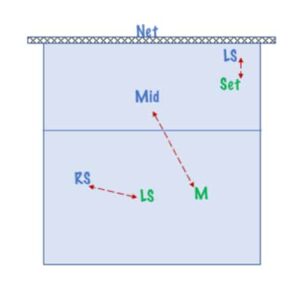
In this example, the setter is in the number 1 position. She needs to stand behind the left-side hitter in the number 2 position during the serve. Player 2 would attack from that position, then switch into their left-side home position. Player 3 would hit from the middle, and player 4 would hit from position 4, then switch to the right-side after the ball goes over after the first rally.
The players in the back court would also switch into their appropriate defensive positioning, so that the players end up looking up like this:
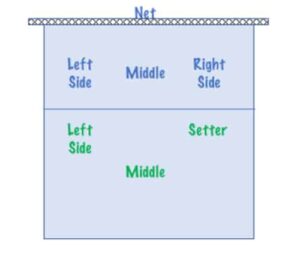
After the rally is over, players need to go back to their rotational order for the serve. Then, after each serve, they once switch into the position for their specialized role. And they always need to remember the serving order, so they don’t get called out of rotation.
Switching, specialized positions, and rotating may seem complicated, but it all comes together when you’re on the court. After a while, you don’t even think twice about rotating or switching – it just becomes second nature.
The best advice I can give related to positions and rotating is to keep it as simple as possible! There will always be a rally or two when players get stuck trying to switch, or they switch too early, leaving a hole in the defense. And some players will just straight up get confused. But, if you keep your team’s setup as simple as possible, players will adapt well, and really start to feel comfortable in their position. Keeping it simple and good communication are the most important things you can do to make the most out of your positions and rotation.
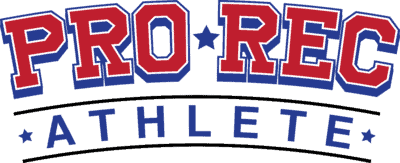

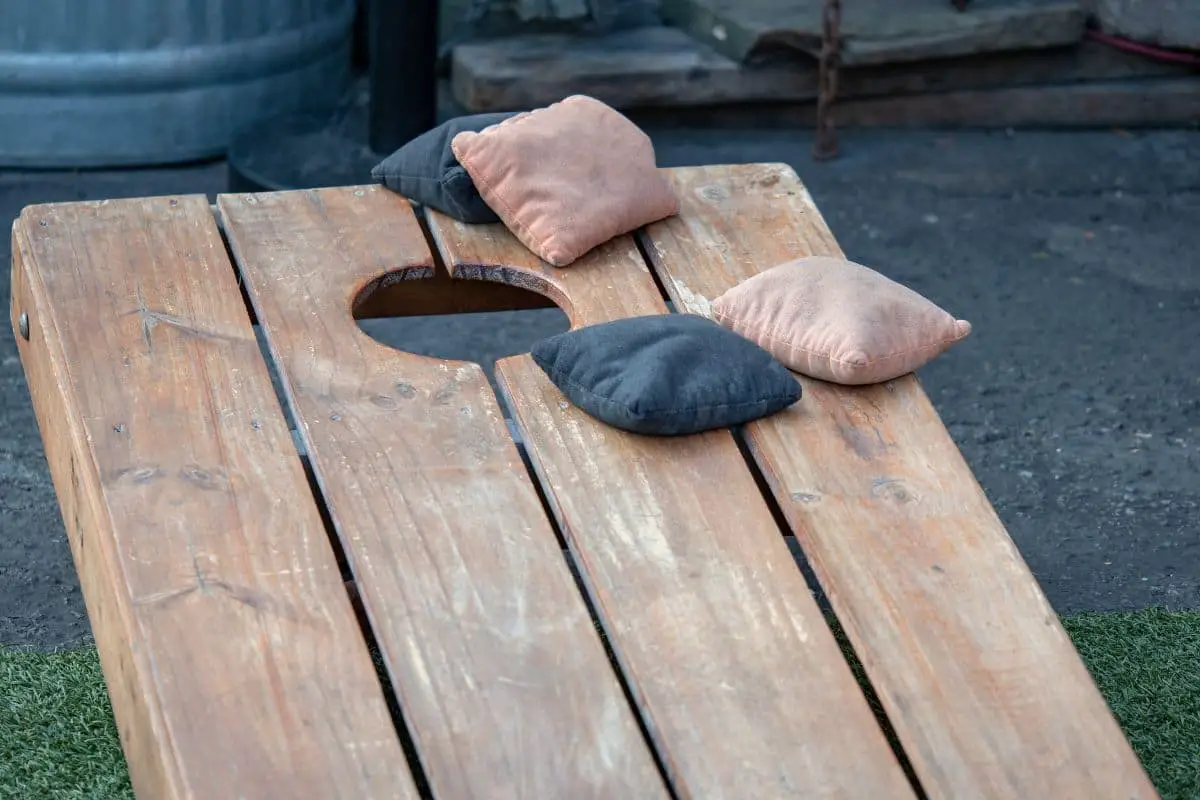
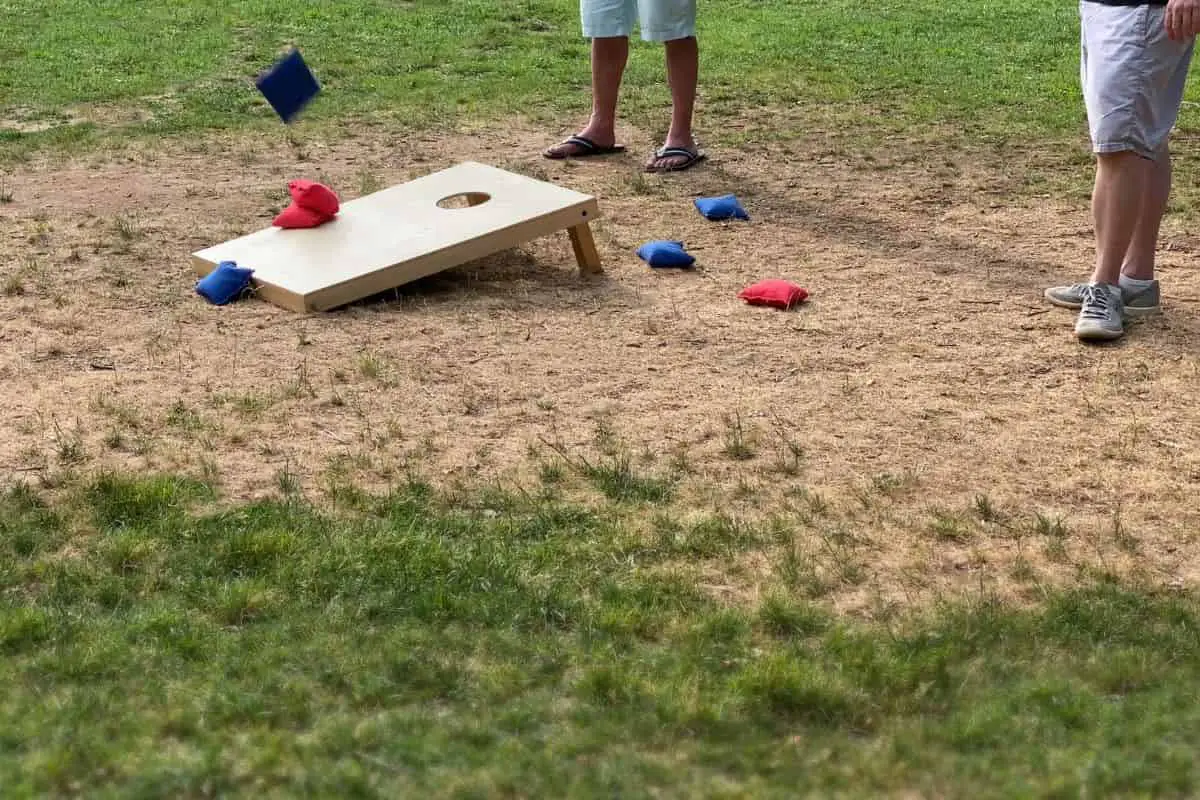
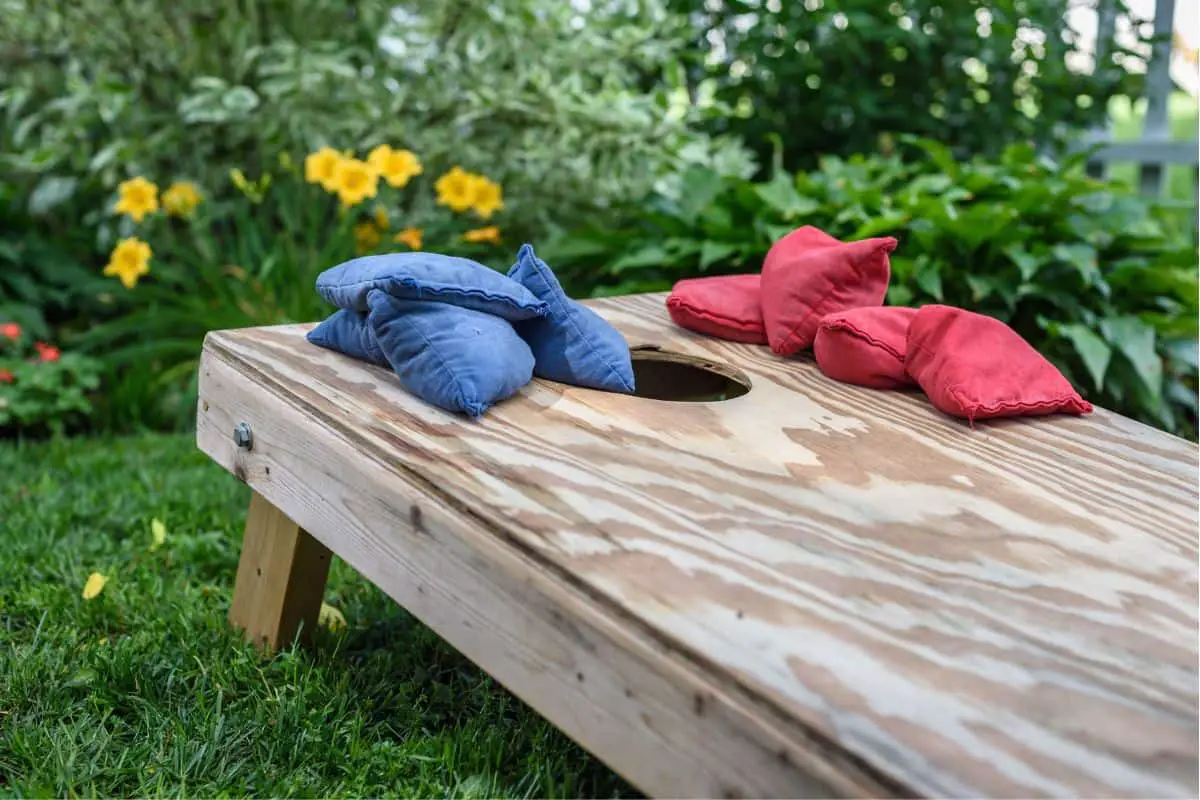
Leave a Reply
You must be logged in to post a comment.